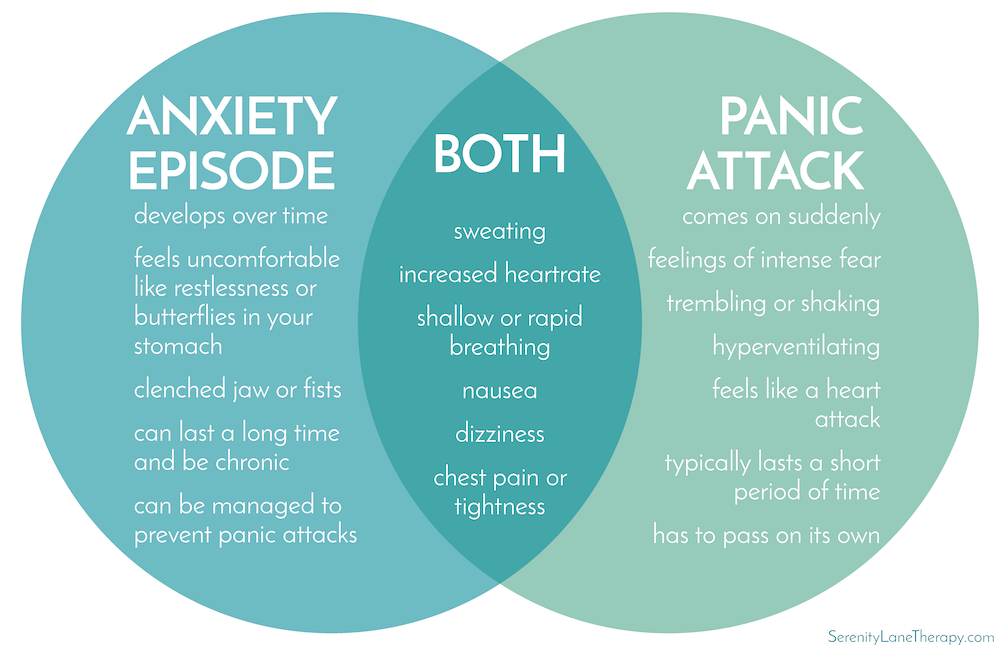Everyone has experienced anxiety at some point in their lives – with a job interview, starting a new job or losing a job, taking a test, going through a divorce, awaiting an approaching hurricane, or even paying your monthly bills. It’s normal to feel anxious during these times and it doesn’t mean you have mental illness or a clinical issue. Anxiety is a healthy emotion – it’s your body’s way of communicating with you. It signifies something needs to be done and gives us the drive to take initiative, make change, or act on something. It brings attention and awareness to what’s going on in your life. If we didn’t have anxiety about taking a test, we wouldn’t be cramming the night before. When your anxiety is mild or moderate, it forces you to pay attention to the current situation.
Anxiety as an Emotion
Mild and moderate anxiety looks like worrying, being stressed out, feeling nervous or fearful in the moment, or worrying about something happening in the near future. That feeling eventually passes and is appropriate for the situation at hand. Maybe you’re feeling restless, distracted, agitated, etc. but it’s rational and proportional. When the situation is resolved or dissipates, or you’re close to finding the solution, the anxiety declines and you can move on.
If you reshape your view on and relationship with anxiety, you can begin to understand it as an emotion. There is no such thing as a bad emotion, so it makes anxiety less scary. A lot of the time anxiety has a bad reputation attached to it because no one wants to be in a state of worry. It’s not enjoyable or pleasant. But from a non-clinical perspective, everyone, at some point in their lives, has experienced anxiety as an emotion. When we reframe our relationship with anxiety, we can practice being nonjudgmental towards it. The emotion is communicating something and we should be aware of it, trust it, not judge it.
Anxiety as a Clinical Issue
When anxiety escalates from moderate to severe, or becomes chronic and doesn’t dissipate when the situation resolves, it becomes a clinical issue. Generalized anxiety, social anxiety, and anxiety episodes are more likely to impact or limit your daily functioning. It can add to additional stress or distress because it’s being experienced and disproportionate to the situation at hand. It might start off more rational, but your perception, viewpoint, or thoughts might be overly exaggerated or irrational so it’s no longer productive.
When anxiety is heightened and/or prolonged, your behavioral reaction will likely follow suit. This may include unhealthy coping to try to bring down or mitigate the anxiety, or you might be unable to manage it so it lingers.
Anxiety Episodes
Anxiety can sometimes feel overwhelming and uncomfortable, but can sometimes be an important emotion to experience. Anxiety episodes are similar to panic attacks, just not escalated. You may start feeling flushed, restless, clenching your jaw or fists, butterflies in your stomach, heart racing, etc. It’s important to recognize the symptoms of an anxiety episode so you can prevent it from escalating into a full blown panic attack. Anxiety is episodic and when managed in a healthy way, you are able to come back to baseline quickly and easily. You feel empowered because you brought yourself there and know you have the ability to do it. When we manage anxiety, the goal isn’t to eliminate experiencing it altogether. The aim is to keep anxiety proportional to the situation at hand, to eliminate chronic and debilitating anxiety, and to prevent panic attacks.
Panic Attacks
Not everyone who has anxiety will have a panic attack, but if you are more prone to anxiety in general, panic attacks might be something you have experienced. Sometimes panic attacks are situational, and anyone, even if you don’t have generalized or clinical anxiety, can experience them. Life is tough, there are always stressors.
People with moderate to severe anxiety have a tendency to live in flight or fight mode, having an easily triggered nervous system. By becoming self-aware, more mindful, and incorporating grounding and breathing techniques into our everyday routine, we have the tools easily at our disposal so we know how to use them and they remain accessible. We can maintain our nervous system closer to a baseline level, rather than always having an easily triggered nervous system in flight or fight. When we regularly use our skills, we maintain a broader window of tolerance, rather than responding in a heightened way so quickly, or rather than shutting down and becoming emotionally paralyzed. It takes more to trigger panic attacks and flight or fight.
Panic attacks are a very sudden episode of intense fear that brings on a visceral physiological reaction, whether there’s real danger or not. These symptoms might include shortness of breath, elevated heart rate, heart palpitations, sweating, feeling overheated, trembling, crying, dizziness, intense level of fear, or chest muscle tension. Sometimes it can feel like a heart attack, which then increases the panic and fear. Some of the work in preventing a panic attack include understanding what your body is communicating when you’re in an anxiety episode and not quite in a panic attack. Once you’re in a panic attack, time has to pass to get through it. It will pass, but it’s difficult to bring it down. At some point you’re going to crash – your body can’t be in that state chronically, even though it feels like it might last forever.

Preventing Panic Attacks
As soon as you notice any changes or fluctuations in your body, start your breathing exercises right away. It’s important to be aware of what’s happening in your body so you can intervene very early and prevent panic attacks. Being self-aware and early intervention is a form of self-empowerment.
Practice diaphragmatic breathing – this is where the exhalation is longer than the inhalation. This prevents hyperventilating, which is when the inhalation is longer. When you are doing diaphragmatic breathing, it’s impossible to hyperventilate and will counteract it. It also helps release tension. Just having the knowledge that you won’t hyperventilate can help prevent a panic attack.
Diaphragmatic Breathing
Breathe in for 3 counts, pause for 3 counts, breathe out for 5 counts.
Access whatever tools you have in your toolbox right away when you feel your anxiety begin to heighten. Place an ice cube on your neck, splash your face with water, anything that will lead to a quick response in reducing your anxiety symptoms to take you out of it before it escalates to a panic attack.
During a Panic Attack
Diaphragmatic breathing exercises may not feel as effective during a panic attack because once your anxiety has escalated to that point it may feel like a struggle to even catch your breath. Once you’re at that point, you may have to ride the wave. When you’re in a panic attack, your breath is too shallow to slow it down, so you have to let time do its thing and somehow sit yourself down, and try to calm your irrational thoughts by replacing them. Think or say aloud to yourself, “this is going to pass, it’s OK, I’m OK, it’s going to pass, this will pass” (if you’re able to access that).
Other skills to utilize during a panic attack may include talking to someone. This can help redirect your focus. Another tool might be a grounding exercise. If you can get yourself to do this in a moment of panic, practice 5-4-3-2-1 grounding.
5-4-3-2-1 Grounding
What are 5 things you see around you?
What are 4 things you can touch near you?
What are 3 things you can hear?
What are 2 things you can smell?
What is 1 thing you can taste?
Other ways to ground yourself include holding onto a stress ball for contact and connection, or any other grounding tools you’ve learned in therapy where you’re in touch with your senses to find stabilization.
If you’ve had panic attacks in the past, can you recall what has helped before? Write down all the tools you have, laminate it, and keep it in your phone, wallet, car, etc. as a cheat sheet to help you during moments where you might not be able to recall it on your own.
If panic attacks are not addressed or left untreated, it could develop into panic disorder. When the anxiety escalates, panic attacks can be short, even only a minute, but can feel like a lifetime in the moment.
Learn How to Manage Anxiety
Sometimes anxiety can be overwhelming, but it is possible to reframe our relationship with anxiety, minimize its effects, prevent panic attacks, and find inner peace. Therapy can empower you to find and access the tools you need to live a more peaceful and stable life. Dr. Violante provides teletherapy (online video therapy) to adults living in Florida and New York, as well as all PsyPact enrolled states (listed below). Contact her online or call (754) 333-1484 to request a HIPAA compliant online therapy session.
Offering Online Therapy in 42 States
I am a licensed psychologist in the states of Florida and New York. Additionally, I have Authority to Practice Interjurisdictional Telepsychology (APIT) from the PSYPACT Commission. I provide telehealth (online video therapy) to adults living in the 42 participating PSYPACT states listed below. For a list of current PSYPACT participating states, please visit the PSYPACT website at: https://www.psypact.org/psypactmap.
PsyPact enrolled states:
Alabama, Arizona, Arkansas, Colorado, Commonwealth of the Northern Mariana Islands, Connecticut, Delaware, District of Columbia, Florida, Georgia, Idaho, Illinois, Indiana, Kansas, Kentucky, Maine, Maryland, Michigan, Minnesota, Mississippi, Missouri, Nebraska, Nevada, New Hampshire, New Jersey, North Carolina, North Dakota, Ohio, Oklahoma, Pennsylvania, Rhode Island, South Carolina, South Dakota, Tennessee, Texas, Utah, Vermont, Virginia, Washington, West Virginia, Wisconsin, Wyoming

